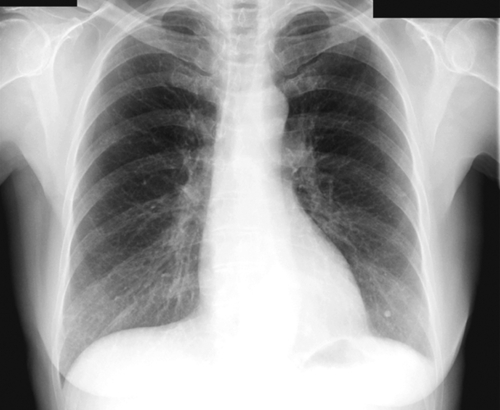History
The patient has had a known cardiomyopathy for 3 years. She had coronary artery disease, with implantation of a bare metal stent (BMS) in the proximal circumflex artery in 2006. The left ventricular ejection fraction was 32% at the last visit to the cardiologist. The patient reported a rhythm disorder, but an electrocardiogram (ECG) has not been performed. She had peripheral artery disease class IIb, with a percutaneous transluminal angioplasty of the femoral artery on the left side in 2007.
Comments
The etiology of cardiomyopathy was unknown. She had cytomegalovirus-related hepatitis in the history, a myocardial biopsy revealed no active inflammation and no bacterial or viral burden, and magnetic resonance imaging did not show signs of inflammation or other structural heart disease.
Current Medications
The patient’s current medications are acetylsalicylate 100 mg/day, enalapril 5 mg/day, metoprolol succinate 95 mg/day, spironolactone 25 mg/day, torasemide 5 mg/day, and atorvastatin 20 mg/day.
Comments
The medication dosage for congestive heart failure was reduced by the cardiologist because of recurrent hypotensive episodes.
Current Symptoms
In June 2008, the patient was admitted to the hospital because of recurrent chest pain unrelated to exercise. In addition, she reported shortness of breath during minimal physical efforts.
Physical Examination
Comments
No actual signs of cardiac decompensation are present and only slight peripheral edema as a sign of congestion.
Laboratory Data

Comments
No relevant abnormalities were reported in the laboratory results. The myocardial markers remained normal in following tests.
Electrocardiogram
Findings
The ECG recorded a sinus rhythm, heart rate of 68 bpm, left axis deviation, left bundle branch block (LBBB), PQ interval 160 ms, QRS 160 ms, and QT 480 ms (Figure 1-1).
Comments
The ECG identified complete LBBB, with QRS greater than 150 ms, which had been described previously.

Chest Radiograph
Findings
Radiography findings were no infiltrates, no congestion, no pleural effusion, normal heart/thorax ratio, and normal heart size. A small calcified, circular formation was seen in the lower left lobe, consistent with a granuloma (Figure 1-2).
Comments
The chest radiograph was normal.
Echocardiogram
Findings
The patient’s left atrial diameter (LAD) was 35 mm, left ventricular end-diastolic diameter (LVEDD) was 62 mm, and left ventricular end-systolic diameter (LVESD) was 54 mm. She had a severely reduced left ventricular ejection fraction (30%), global hypokinesia of the left ventricle, akinesia of posterior wall, septal-to-posterior wall motion delay of 140 ms, aortic preejection time of 150 ms, moderate mitral regurgitation, slight aortic and tricuspid regurgitation, and no pericardial effusion, The inferior vena cava (IVC) and hepatic veins were not dilated (Figure 1-3).
Comments
Highly reduced left ventricular function with significant dyssynchrony was found, with no relevant signs of right heart failure.
Catheterization
Hemodynamics
Hemodynamic monitoring found highly reduced left ventricular function at 28%, moderate mitral regurgitation, no aortic stenosis, left ventricular end-systolic pressure of 128 mm Hg, left ventricular end-diastolic pressure of 20 mm Hg, pulmonary capillary wedge pressure of 34 mm Hg, pulmonary artery pressure of 64/26/44 mm Hg, right ventricular pressure of 60/0/9 mm Hg, right atrial pressure of 6 mm Hg, and cardiac output of 2.8 L/min.
Stay updated, free articles. Join our Telegram channel

Full access? Get Clinical Tree


